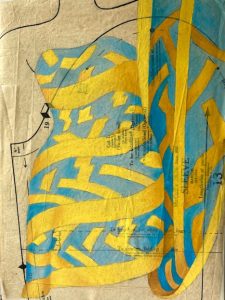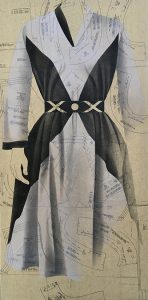Body Language: Lesia Sochor
May 19 – September 2, 2023
Body Language features textile inspired works by Maine-based painter, Lesia Sochor. The daughter of Ukrainian immigrant parents, Sochor grew up in Philadelphia and studied fine art at the Philadelphia College of Art.
A simple spool of thread was the catalyst for Sochor’s inquiry into the ancestral ties between the women in her family and their connections to textiles and sewing. The artist concentrates on thematic narratives through colorful spools, mannequins, and beautiful clothing. Sochor’s consideration of these concepts surrounds the language of textiles into metaphors and narratives that relate to the feminine. They also explore the way in which humans use clothing and fashion to present themselves and define their identity.
The body becomes a dynamic site for the beauty, power, and the art of fashion, but also hints at political overtones. In a broader sense, Sochor is looking at the strengths and weaknesses of how culture has constructed fast fashion and become indentured to it. High fashion has long been associated with the designers and the couture of Paris and New York, but ready-to-wear clothing has come at a cost to humanity. In 2012 the tragic fire in a large garment factory in Dhaka Bangladesh brought awareness to the poor working conditions of the factory and the treatment of the workers. Sochor was moved to paint Made in Bangladesh “as a means of addressing the inequities of labor practices and subjugation of workers in many parts of the world who sew our fashions,” she says.
Sochor’s spool images, painted in oils, were the segue into using pattern paper as a way to articulate the process of sewing. Her translucent images are painted with thin layers of oil placed on a collaged surface of sewing pattern paper on stretched canvas. The markings and multi-lingual instructional text, which remain visible on the pattern paper, are critical to the overall intent of each piece. Incorporating the pattern is not unlike designing and constructing a garment which takes many steps; laying and pinning, the cutting, and finally sewing the fabric. Sochor’s dedication to detail suggests the careful craftsmanship associated with hand-tailored clothing. The semi-transparent layers of paint evoke luscious and sultry drapery and diverse palettes. Sochor brilliantly uses cast shadow and tone to show the curves of her subjects, filling out the attire she has designed for them. Sochor reveals her versatility as a painter with the movement of Cinderella and the stillness of Jazz Fest Mama. There is a juxtaposition of the sumptuous folds of fabrics like Leopardess to the crisp lines of the mannequin form series.
In several works, Sochor pays homage to some of her artistic influences by painting fellow Ukrainian artist, Louise Nevelson and painter, Georgia O’Keefe. Sochor says, “Both of these women consciously crafted a signature style of dress which was aesthetically and intentionally driven to create an image; a persona. Their clothing was an authentic form of expression – their whole lives were works of art.” Sochor illustrates this by creating one of O’Keefe’s understated dresses of black and white by adhering to the simple elegance of the garment. – “the use of a ‘Simplicity’ pattern emphasizes the symmetry and geometry of the dress.” In contrast, Nevelson is the only body in the exhibition painted with a head to convey the gestalt of Louise. Sochor explains, “It was imperative in creating her persona to portray her scarf and false eyelashes.” This work is a testament to how clothing and fashion are imbedded in history as well as identity.
Left: LESIA SOCHOR (Ukranian American, born 1952). Sonia, 2023. Oil on collaged sewing pattern paper. Courtesy of the artist.
Right: LESIA SOCHOR (Ukranian American, born 1952). Georgia, 2017. Oil on collaged sewing pattern paper. Courtesy of the artist.



